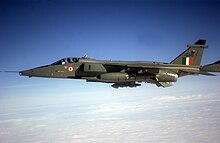Jaguar is an Anglo-French jet ground attack aircraft, originally used by the British Royal Air Force and the French Armée de l'Air in the close air support and nuclear strike role, and still in service with several export customers, notably the Indian Air Force and the Royal Air Force of Oman.
Originally conceived in the 1960s as jet trainer with a light ground attack capability, the requirement for the aircraft soon changed to include supersonic performance, reconnaissance and tactical nuclear strike roles. A carrier-based variant was also planned for French service, but this was cancelled in favour of the cheaper Dassault Super Étendard. The airframes were manufactured by SEPECAT (Société Européenne de Production de l'avion Ecole de Combat et d'Appui Tactique), a joint venture between Breguet and the British Aircraft Corporation, one of the first major joint-Anglo-French military aircraft programs.
The Jaguar was successfully exported to India, Oman, Ecuador and Nigeria. With various airforces, the Jaguar was used in numerous conflicts and military operations in Mauritania, Chad, Iraq, and Bosnia as well as providing a ready nuclear delivery platform for Britain, France, and India throughout the latter half of the Cold War and beyond. In the Gulf War, the Jaguar was praised for its reliability and was a valuable coalition resource. The aircraft served with the Armée de l'Air as the main strike/attack aircraft until 1 July 2005, and with the Royal Air Force until the end of April 2007. It was replaced by the Panavia Tornado and the Eurofighter Typhoon in the RAF and theDassault Rafale in the Armée de l'Air. India plans in the long term to replace its Jaguar fleet with the developing Advanced Medium Combat Aircraft (AMCA).
Jaguar of the Indian Air Force during Cope Thunder exercise in Alaska.
India had been approached as a possible customer for the Jaguar as early as 1968, but had declined, partly on the grounds that it was not yet clear if the French and British would themselves accept the aircraft into service. However, a decade later they would become the largest single export customer, with a $1 billion order for the aircraft in 1978, the Jaguar being chosen ahead of the Dassault Mirage F1 and the Saab Viggen after a long and difficult evaluation process. The order involved 40 Jaguars built in Europe at Warton, and 120 licence-built aircraft from Hindustan Aeronautics Limited (HAL) under the local name Shamsher ("Sword of Justice").
As an interim measure, 18 Royal Air Force Jaguars were loaned to the Indian Air Force, with the first two loaned aircraft operational with Western Air Command on 27 July 1979. The second batch of aircraft for the Indian Air Force were 40 Jaguar Internationals built at Warton, the first aircraft being delivered in March 1981. Batch Three was the assembly of another 45 aircraft by HAL of kits shipped from the United Kingdom, the first kit being shipped to India in May 1981.In the following phases more aircraft would be built in India with less European content.
A pair of Indian Jaguars flying in formation besides a pair of Indian Navy Sea Harriers and a pair of F/A-18 Super Hornets, flying over the Indian Navy aircraft carrier INS Viraat during exercise Malabar.
Indian Jaguars were used to carry out reconnaissance missions in support of the Indian Peace Keeping Force in Sri Lanka between 1987 and 1990. They later played an active role in the 1999 Kargil War with Pakistan, dropping both unguided and laser-guided bombs, the IAF defining its role as a "deep penetrating strike aircraft". The Jaguar is also used in small numbers for the anti-ship role, equipped with the Sea Eagle missile.The Jaguar remains an important element of the Indian military as, along with the Mirage 2000, the Jaguar has been described as one of the few aircraft capable of performing the nuclear strike role with reasonable chances of success. However, it has been alleged that the Indian military rejected developing the Jaguar into an active nuclear platform due to a lack of ground clearance for deploying India's gravity-dropped nuclear bombs.
As the aircraft aged, the avionics were viewed as lacking suitable components for the ground attack mission such as terrain-following radar, GPS navigation, and modern night-flight systems; consequently, several upgrades were carried out in the mid-1990s, including the addition of the Liteningtargeting pod. India placed an order for 17 additional upgraded Jaguar aircraft from Hindustan Aeronautics in 1999 and a further 20 in 2001–2002.The Indian Air Force plans to upgrade up to 120 Jaguars by fitting more powerful engines, either Adour Mk821s or Honeywell F125IN to improve performance, particularly at medium altitudes.











0 comments:
Post a Comment